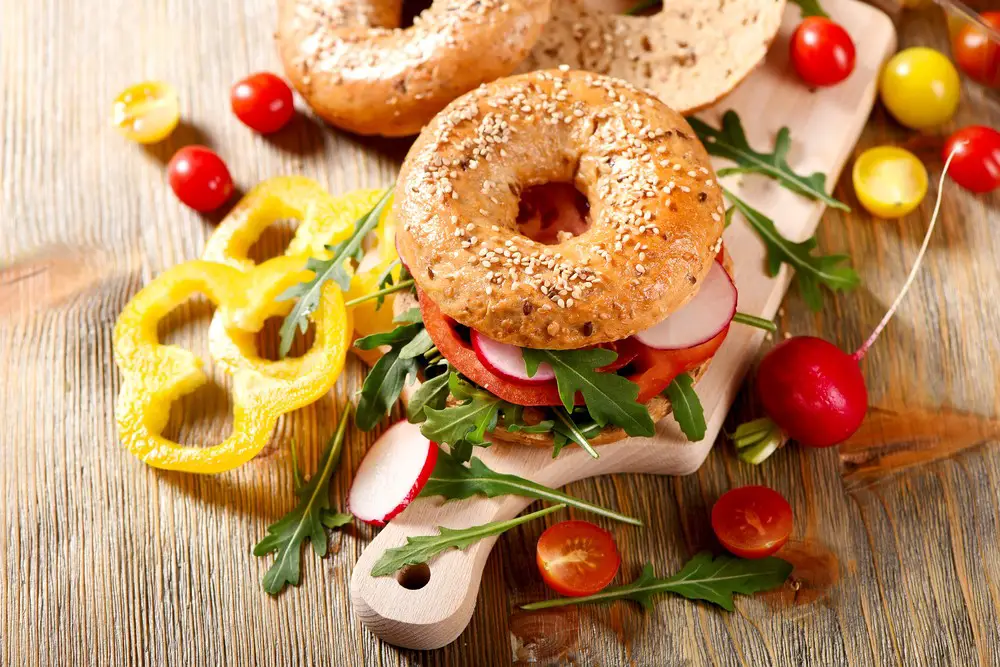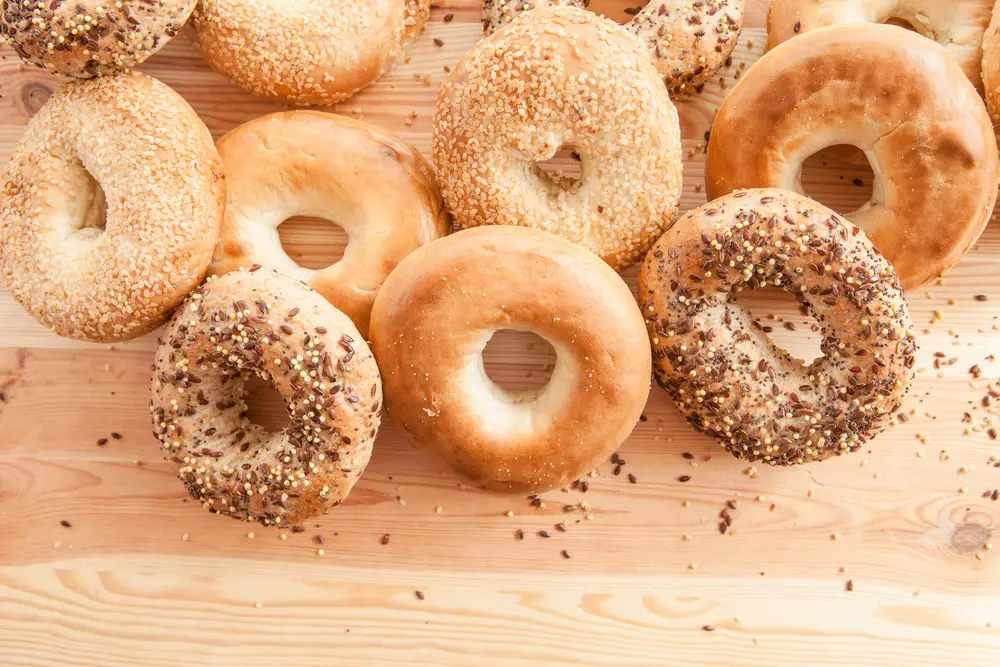Bagels have become a delicious breakfast staple thanks to their easy pairing with sweet and savory toppings. However, if you have recently embraced veganism, you may ask yourself: are bagels vegan?
Let’s delve deeper into bagel history and production, covering what you need to know about this American, and not only, favorite bread style.
Bagel History
Many nations have bread resembling bagels, but the earliest mention of a similar style of boiled and baked version comes from a Syrian cookbook from the 13th century, referring to the bread as ka’ak.
According to this interesting article on bagels in The Atlantic, German migrants to Poland in the 14th century popularized pretzels as a feast bread. At the time, pretzels were a thick bread popular poplar in German monasteries, but their move east led to the bread evolving into one called obwarzanek, a bagel-like bread preferred by royalty and the rich during Lent. However, expensive wheat flour was required to make the bread, unlike the cheaper rye flour used to make the coarser bread eaten by most Poles.
However, Poland also had a well-established Jewish community during that time. Radical regulations forbade them to handle bread, but one theory says that a ruling allowed them to handle boiled bread. Known as beygal in Yiddish, traditionally, they presented it to women during childbirth.
Another version of the bagel story is about a Viennese baker creating their stirrup shape (beugal in German) in the late 17th century in honor of the Polish King’s love for horses and his successful defense against the Turkish army.
By the mid-19th century, bagels became popular in England, and a bit later, immigrant Polish Jews introduced them to the United States.

Are Bagels Vegan?
Bagels are just like bread, containing a mixture of flour, yeast, water, and salt. However, they may also have a little fat and sweetener. What makes them different from bread is that they require a different production method. As a result, they have a firm and dense spongy texture that makes them chewy, thanks to using bread flour or high gluten flour.
Once kneaded, bagels get rolled into their donut shape, boiled, and allowed to dry before getting their dusting of seeds (poppy, sesame, sunflower, etc.) and baking.
Basic Bagel Ingredients for Vegan Bagels
Yeast – Bagel dough must rise to give it its characteristic spongy texture and flavor. Therefore, yeast is a crucial ingredient.
Flour – White wheat or bread flour are popular flour choices for bagel-making. But you can also find bagels made with whole wheat, multigrain, or wholegrain flour.
Salt – Salt plays a dual purpose in bagels. It provides flavor and helps the dough to rise by regulating the yeast.
Fat – A small amount of vegetable oil or shortening helps enhance the texture and taste of bagels.
Water – As in most bread doughs, the liquid helps bind all the ingredients to create the perfect dough; traditionally, it’s water.
Sweetener – Most basic bagel recipes have a slightly sweet flavor. Bagel makers use either sugar, molasses, barley malt syrup, malt extract, or corn syrup. Some even use honey, so if you are vegan, check first.
Added Ingredients – Some additional ingredients are often used to enhance the texture, color, and flavor. Ingredients added as toppings or into the dough include seeds, nuts, grains, spices, herbs, fruits, and vegetables.
Ingredients Making Bagels Non-Vegan
In your quest to find the answer to your question: Are Bagels Vegan? – consider that sometimes bagels have non-vegan ingredients. These are the ingredients you must make sure are not included in your favorite bagel:
Dairy – The most common form of dairy added to bagels is milk to give the bagel a creamier flavor.
Eggs – Including eggs in the bagel dough ensures a lighter and softer dough. Sometimes, bakers use an egg wash to make the bagel shinier and more appealing.
Honey – Not all sweeteners are vegan, so if you avoid honey, you must ensure your bagel doesn’t contain it as a sweetener.
L-Cysteine, Lecithin, Monoglycerides, and Diglycerides – One of the most common non-vegan additives found in flour is L-cysteine, added as a dough conditioning agent. On a label, you will either see it written as L-cysteine, or it will appear as E920. Unfortunately, this ingredient often contains feathers or hair (human or pig origin). In some cases, it may be from a vegan source. Commercial bakers also use other emulsifiers like Lecithin, monoglycerides, and diglycerides, which are often soy-derived but sometimes derived from animal products.
Toppings and Fillings – Often, the toppings and fillings for bagels are also not vegan. These include dairy products (cream, cheeses, and cream cheese), egg products like regular egg or eff-based sauces like mayonnaise and hollandaise, processed meats, and fish products (smoked salmon, tuna, and caviar).

Ensuring Your Bagel is Vegan
Therefore, our answer to your question, “Are bagels vegan?” is that sometimes they are, but often they aren’t. Here’s how to ensure you’re always getting a vegan bagel:
1. Always Read the Label
If you prefer to buy your bagels from the shelf, always read the label to ensure the ingredients used come from a vegan source. If the label is unclear, contact the manufacturer for more details.
Some restaurants and grocery store labels that carry vegan bagels include Starbucks, Dunkin Donuts, Panera Bread, Einstein Bros. Bagels, Trader Joe’sand Bruegger’s. However, when in doubt, ask which variants are.
2. Vegan Certification
Even though most countries don’t require vegan labeling by law, some commercial manufacturers of bread products and other foodstuffs get certification from independent organizations.
However, not all vegan products have certification, and some certificates may not be reliable. Therefore, always read the label and check out the organization’s requirements to ensure they meet your criteria.
3. Bake Your Bagels at Home
You can make your own home-baked bagels, ensuring they are always vegan. Try this easy recipe using just three ingredients from Sweet Simple Vegan. Once you have your perfect batch of bagels, make your favorite vegan toppings like vegan whips, tofu, grilled vegetables, and herbs, and enjoy your flavor combinations.
Final Take
You can avoid the unwanted ingredients in most bagels by opting for the plainer options made with classic ingredients or making them at home. Then, once you have your favorite vegan bagel, add your favorite vegan spreads and toppings and enjoy!
What are vegan bagels?
Vegan bagels are made with flour, yeast, salt, oil or shortening, water, and sweetener. These ingredients must be from a vegan source. For toppings and fillings, avoid dairy products (cream, cheese, cream cheese), egg products like mayonnaise and hollandaise sauce, processed meats, and fish products like smoked salmon.
Where can I buy vegan bagels?
You can find vegan bagels in many grocery stores and restaurants, including Starbucks, Dunkin Donuts, Panera Bread, Einstein Bros. Bagels, Trader Joe’s, and Bruegger’s Bagel Bakery. However, it is always best to check the label of ingredients and ask the store staff what vegan options are available.
Can I make my own vegan bagels?
Yes, you can make your own vegan bagels easily using just three ingredients. Details are on the bottom of this article. Once you have prepared your perfect batch of bagels, add toppings or fillings, such as veggies, herbs, and plant-based spreads for a delicious snack.
Are all bagels vegan?
No, not all bagels are vegan as some may contain dairy products, egg products, processed meats, and fish products. It is important to read labels carefully to ensure that the ingredients used in making the bagel are vegan-friendly. Additionally, some restaurants and stores may offer vegan options, so it is always worth asking what options they have.

